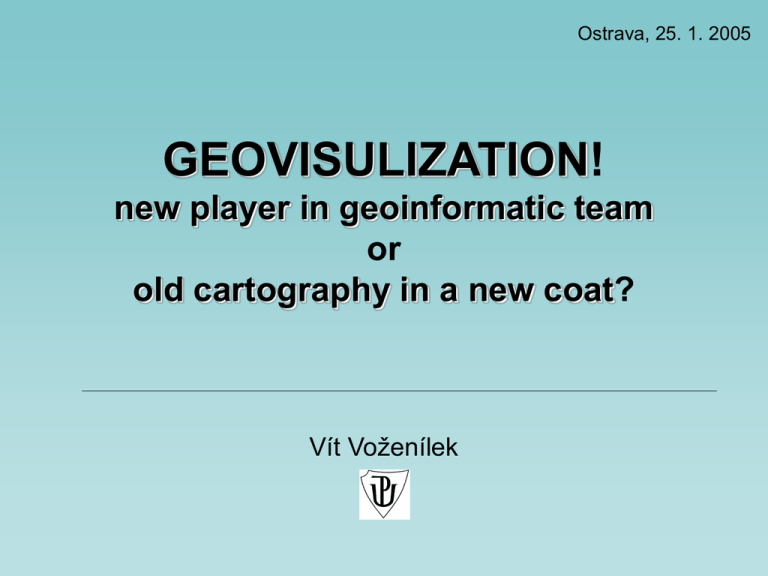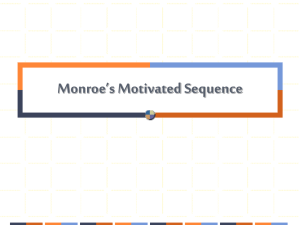new player in geoinformatic team or old cartography in a new coat?
advertisement

Ostrava, 25. 1. 2005 GEOVISULIZATION! new player in geoinformatic team or old cartography in a new coat? Vít Voženílek Scientific visualization • Visualization capitalizes on the strength of human perceptual abilities. – The human brain has an impressive capacity for the understanding and assimilation of graphically presented information. – Visualization tools provide the means to filter and explore rapidly growing quantities of spatial data, perceive patterns that may be apparent at one resolution but may otherwise remains hidden at other resolutions, transform surface data to simulate 3D and develop representations of temporally changing landscapes unlimited by constraints of a single-view map – The graphic representations stimulate visual thinking and facilitate geographic problem-solving. • Current visualization technology provides a full range of HW and SW from static 2D plots, to interactive 3D images allowing the user to interact on a human scale. • Scientific visualization is „a tool for both interpreting image data fed into a computer and for generating images for complex multidimensional data sets“. – The ideas of VISC are slowly permeating the geographical and cartographic communities, particularly among those practitioners engaged in computer-based work. The nature of visualisation • three dimensional model of human-map interaction space by MacEachren – that defines what might be considered prototypes for visualization and communication • from map use that is private (tailored to an individual) to public (designed for a wide audience), • map use that is directed toward revealing unknowns (exploration) versus presenting knowns (presentation), • map use that has high interaction versus low interaction. The continuum of visualization from public to private use • although the categories, static images, interactive visualization and mental visualization are depicted as separate, the boundaries between them are fuzzy and the range is actually continuous and interactive • the main uses of the different categories, although the boundaries are also fuzzy Cartography and visualisation • graphical presentation of information has a long history (some of the earliest graphical presentations are maps) • cartography has had and to have an important role to play in the graphical presentation of geospatial information • Fairbairn defined cartographic representation „as the transformation that takes place when information is depicted in a way that can be perceived, encouraging the senses to exploit the spatial structure of the portrayal as it is interpreted. These representations are usually graphical, but may also be haptic or audible, or involve elements that mix other senses with sight“. • the most critical issues in cartographic research: – – – – – the characteristics of the data to be handled the visual design and the user interface the representation purpose user interaction with dynamic representations the changing technology to support new forms of representation (how representations can be accessed and enhanced). The spatial media may have four types of media functions (according to cognition science) • function of demonstration – by using media to give a realistic picture (demonstrate the idea, object or landscape) with photos, videos or virtual reality • function of putting into context – to put the detailed information into a bigger context, like an overview of the area (for spatial context), or sounds that are related to a particular area may help the user to identify and position the given information • function of construction – It is related to the creation of complex mental models by the user – abstract media of pre-prepared information is best suited for this function, such as graphs, diagrams or abstract layers • function of motivation – to stimulate on the user interest and attention – this can be achieved with animations, interactive objects, e.g. interactive fly-overs are a typical example for this function 3D visualization • All communication between the readers of an image and the makers of an image now take place on a twodimensional surface. – Escaping this flatland is the essential task of 3D geovisualisation – for all the interesting worlds (physical, biological, imaginary, human) that people seek to understand are inevitably and happily multivariate in nature • 3D visualization provides an effective way of presenting large amounts of complex information to a wide audience, including those with no GIS or mapping experience. • The 3D visualization systems were designed taking into consideration cognitive principles and are able to integrate high quality mapping of the current situation, 3D representations of the future and (geo)multimedia (regarding real world information). DiBisae's model of the role of maps in scientific visualization • Cartographers need to direct attention to the role of maps at the early (private) stages of scientific research where maps and map-based tools are used to facilitate data sifting and exploration of extremely large data sets 3D visualization in GIS with SiteBuilder 3D, plug-in for ArcGIS with ESRI´s 3D Analyst 3D visualization in GIS with Autodesk Map 3D 2005 3D visualization in GIS with Precision Lightworks Nverse Photo, a plug-in for Autodesk VIZ or Discreet 3ds max 3D visualization in GIS with software from NGRAIN Corporation Below are five important advantages to digital map: • Real-time redesign – Digital maps can be redesigned by the user base and specific need. This advantage is very important to expert users who know a significant amount about the thematic content of the map and the how the digital system works. • Identity – The ability to identify an object on the map provides a robust interaction with graphic elements not available to paper maps. • Query – The ability to query information related to the map form is an exciting advantage. By developing a query environment through the map, map readers can reduce the complexity of the spatial information and focus only on selected elements. • Links to non-spatial databases – The link to data allows digital maps to access additional information not currently shown on the map. • Spatial analysis – The final advantage of the digital map is the ability for the user to perform both simple and complex spatial analysis tasks such as buffer, overlay and others. The ability to perform analysis makes the digital map a process based analytical tool. The paper map has five properties that would benefit the digital map: • Cartographic fidelity – printed map is printed using high standards for print resolution and color quality – for the computer this is limited to the technical specification of the visual output device • Display size – maps can be print on paper exceeding the size of video devices • Power consumption – paper maps do not need to use power unless artificial light is needed to view it • Portability – it means a function of size, weight and power – computers are getting smaller PDA, tablet PC and others, but increasing portability causes more problems for cartographic fidelity and display size • End user cost – digital maps are not cheaper than paper! – one can download a route map with four clicks of the mouse and not pay a fee for the map itself. But the information on the Internet is not free. One must have a computer, software and Internet providing to access a world wide web site – some of costs are ongoing and deferred through much usage, but still the cost for digital maps are expensive compared to a road atlas with a cost of each map being pennies. So the cost to the end users is still high for digital maps vit.vozenilek@upol.cz






